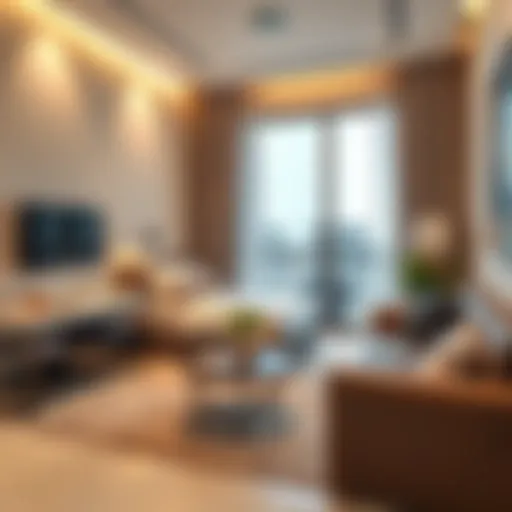Exploring IKEA in the UAE: Insights and Trends


Intro
Exploring the world of home furnishings can be fascinating, especially when considering brands that have made significant strides in international markets. IKEA, a household name in affordable and stylish home goods, occupies a unique position in the United Arab Emirates. Their foray into this diverse market stands as a testament to their adaptability and understanding of local consumer needs. The following sections will guide readers through the significance of IKEA’s presence in the UAE, its impact on lifestyle trends, and the experience of shopping at its stores located in bustling cities like Dubai and Abu Dhabi.
Market Insights
In order to grasp the influence of IKEA in the UAE, it's essential to first look at the backdrop of the local market. The apparent boom in real estate, particularly in Dubai, has led to surging demand for stylish and functional furnishing options. With a rapidly expanding population and an influx of expatriates, IKEA has positioned itself as a go-to supplier for many looking to establish their home life in a new city.
Current Trends in Dubai Real Estate
Dubai's real estate sector is currently experiencing notable fluctuations. The past few years have witnessed a cycling of both buyers and renters, with trends seeing a move towards more suburban areas where larger living spaces are available. This shifting preference directly impacts home furnishing needs as residents search for ways to maximize both comfort and functionality in their living spaces.
Some prevalent trends here include:
- Increased focus on sustainability: Many consumers now prioritize eco-friendly options when it comes to home goods.
- Preference for customized spaces: People are gravitating toward purchasing versatile furniture that allows them to adapt their environments based on evolving needs.
- Integration of technology: Smart furniture is gaining traction, particularly among tech-savvy younger generations.
Emerging Areas and Investment Hotspots
Gazing beyond the high-profile areas of Dubai, some emerging neighborhoods are quickly becoming the toast of real estate investors. Locations like Dubai South and Dubai Creek Harbour showcase expansive environments that appeal to families and young professionals alike. These regions are often characterized by:
- Proximity to major transport links: Accessibility is crucial for residents, especially in the bustling corporate landscape of Dubai.
- An array of amenities: Buyers and renters tend to prefer areas with easy access to schools, parks, and shopping centers.
- A blend of community living and modern architecture: The design ethos in these areas supports a sense of belonging while catering to the tastes of contemporary occupants.
Buyer and Renter Guidance
Understanding the current market trends provides valuable insights for potential buyers and renters. As someone navigating the home furnishing landscape, it's crucial to approach your search equipped with knowledge about processes and local nuances.
Comprehensive Buying Process in Dubai
The buying process in Dubai can differ from many other markets, primarily because of its unique legal framework. Key steps often include:
- Finding the right property: Whether it’s purchasing or renting, do extensive research on various neighborhoods.
- Engaging a trusted real estate agent: Consider working with agents who are well-acquainted with the area and market trends.
- Paperwork and due diligence: Ensure that all legalities, including title deeds and property checks, are completed thoroughly.
- Finalizing the transaction: Be prepared for negotiations and securing financing that could involve local banks or international lenders.
Essential Tips for Renters in Dubai
Renters must be savvy to navigate through the abundant options available. Here are a few practices to consider:
- Budget wisely: Understand the full spectrum of rental costs, including community fees and utilities.
- Explore various platforms: Utilize both local and international real estate websites to expand your options, like Property Finder and Dubizzle.
- Be adaptable: If you have flexibility in your home choice, be open to areas that may be a bit further from the city center but offer better value.
Understanding IKEA's role in this dynamic market unfolds layers of consumer behavior and lifestyle changes, signifying a shift towards modern living solutions that resonate well with both locals and expatriates. Not only does it supply furniture, but it shapes the way people in the UAE conceive their spaces, underscoring the brand's impact on the local lifestyle.
Prologue to IKEA in the UAE
IKEA, known for its innovative designs and accessibility, has carved out a significant niche in the United Arab Emirates. Understanding its role not just as a furniture retailer but also as a cultural phenomenon is essential for those interested in the country's evolving home furnishings market. This exploration is vital, especially for real estate investors, expatriates, homebuyers, agents, and landlords, as it illuminates trends in consumer behavior and lifestyle choices that directly influence property value and desirability.
The UAE represents a melting pot of cultures and lifestyles, making it an intriguing playground for IKEA's concept of democratic design—affordable solutions that don't compromise on aesthetics. With a growing expatriate population and an increasing emphasis on modernity in home design, IKEA's adaptation to local tastes and preferences further solidifies its importance in the market.
Concept and Values of IKEA
IKEA’s ethos revolves around a simple yet profound concept: "Design for everyone." This means making stylish furniture available at prices that won’t break the bank. The Swedish brand encapsulates value, innovation, and sustainability, all while being mindful of the needs of diverse consumers. In the UAE, this approach resonates strongly, as both locals and expatriates seek practical and aesthetically pleasing furniture solutions that fit their unique living environments.
The company embraces core values such as sustainability and community involvement, which are paramount in the socially conscious market of the UAE. By using sustainable materials and offering eco-friendly products, IKEA aligns itself with a demographic keen on living harmoniously with the environment. Its commitment to recycling and reducing waste reflects broader, global trends toward sustainability, proving especially relevant in a region grappling with environmental challenges.
History of IKEA in the UAE
IKEA's journey in the UAE began in the late 1990s, a period marked by rapid urbanization and a growing appetite for modern furnishings. The first store opened in Dubai in 1991—Cultural landmarks such as the Burj Khalifa and Palm Jumeirah were still dreams, and the retail landscape was evolving quickly. This first store, built in the heart of
Dubai, attracted a diverse clientele drawn by the allure of Scandinavian design coupled with affordability. Over the years, expansion into Abu Dhabi and other emirates followed, reflecting IKEA's ambitious plans to establish itself as a household staple in the region.
Notably, in 2010, IKEA introduced its signature family card, promoting a sense of community among customers. This initiative not only bolstered customer loyalty but also incorporated cultural values that prioritize family gatherings and home life.
IKEA's history in the UAE is one of adaptation; it recognizes local tastes, which translates into product offerings that respect and celebrate local customs. As the region continues to develop, IKEA’s evolution will likely influence upcoming design trends and consumer preferences.
"IKEA isn`t just a store; it’s a cultural touchstone for those setting up homes in the UAE, integrating Scandinavian simplicity into the hustle and bustle of Middle Eastern life."


In summary, understanding IKEA's concept and history in the UAE is crucial for grasping the intricate dynamics of the home furnishing industry and its broader implications for lifestyle and consumer habits in this vibrant region.
Store Formats and Locations
Understanding the store formats and locations of IKEA in the UAE provides key insights into how the company has successfully integrated into the local market. This section highlights not just the physical presence of IKEA, but also the evolving landscape of retail shopping in one of the most dynamic regions in the world. The benefits of these formats go beyond mere convenience; they reflect the brand's commitment to accessibility and customer experience.
Flagship Stores in Dubai and Abu Dhabi
IKEA operates several flagship stores across the UAE, with the largest located in Dubai and Abu Dhabi. These massive stores are designed as one-stop shops offering an extensive range of products. The flagship store in Dubai is particularly notable, showcasing a vast collection of furniture and home accessories, spread over an area that feels almost like a small town. More than just a retail store, these flagship outlets serve as inspiration centers, often featuring fully furnished rooms that allow customers to visualize how products might fit into their own homes.
The experience in these stores differs heavily from smaller retail spaces, creating a unique atmosphere that encourages exploration and discovery. One can hardly miss the Swedish meatballs wafting through the air, which has become a signature offering, drawing in even those who might not be in the market for new furniture. The sprawling layouts are planned to guide visitors through various departments, ensuring they don’t just make a purchase, but also enjoy the journey.
Furthermore, these flagship stores engage heavily with the community, often hosting workshops or family activities that create a sense of belonging among local residents. Such initiatives enhance the overall shopping experience and serve to strengthen brand loyalty among consumers.
The Role of Online Shopping
In today’s digital age, online shopping is more than a convenience; it has become a necessity. IKEA’s online presence in the UAE complements its physical locations efficiently. Customers can browse the wide selection of products from the comfort of their homes, which is especially relevant in a region that values both modernity and tradition.
The website is user-friendly and designed to reflect the essence of IKEA’s in-store experience. Shoppers can easily navigate through categories, view detailed product descriptions, and even get personalized recommendations based on previous purchases or browsing history.
"Online shopping allows IKEA to reach customers across the UAE who may not have easy access to a flagship store."
Additionally, the convenience of online ordering means that home deliveries can be scheduled flexibly, accommodating the busy lifestyles of expatriates and locals alike. With features like virtual room planners, customers can visualize how selected items will look in their space before making a purchase, which can be a major advantage when deciding on larger furniture pieces.
In contrast to traditional retail methods, the online platform caters to a growing demographic that values efficiency and accessibility, allowing for a seamless blend between physical and digital shopping experiences. By continually investing in their online systems, IKEA not only enhances customer satisfaction but also significantly broadens its market reach in the UAE.
Product Offerings Tailored to the UAE Market
Understanding IKEA’s product offerings in the UAE is vital to grasping the brand's influence on the local home furnishing market. The UAE comprises a unique blend of expatriate communities and local traditions, and IKEA has recognized this by aligning its products accordingly. By taking into account cultural preferences, lifestyle needs, and economic factors, IKEA crafts its range to resonate with a diverse clientele. This section delves into three key aspects: cultural adaptations, popular product categories, and sustainability in product design that distinguishes IKEA within the UAE.
Cultural Adaptations and Regional Preferences
To begin with, cultural sensitivity plays a significant role in IKEA's success in the UAE. The furnishings and lifestyle preferences here are not only influenced by modern Western trends but also by deep-rooted customs. For instance, larger sofas that accommodate multi-generational families are common in Emirati homes, while sleek, minimalist pieces might appeal more to the younger expatriates seeking to maintain a modern aesthetic.
Additionally, households in the UAE often require flexible furnishing solutions due to the transient nature of many residents. Items like modular seating or versatile storage options are crucial in creating adaptable living spaces.
Consider the following points:
- Arabic-inspired designs: IKEA has introduced furniture that incorporates traditional Arabic design elements, making it suitable for local tastes.
- Seasonal collections: During Ramadan, you may notice items that reflect the spirit of this holy month, catering to families looking for tailored decorations or dining solutions.
- Customizable options: Allowing customers to tailor their choices also appeals greatly to those from various backgrounds.
Popular Product Categories
When one thinks of IKEA, several product categories come to mind that have found a dedicated market within UAE. The furniture giant has adapted its offerings to not only suit the aesthetic preferences of consumers but also the practical necessities dictated by lifestyle trends. Some of the standout categories include:
- Outdoor Furniture: Given the emphasis on alfresco living, with many residents who enjoy outdoor gatherings, IKEA offers a range of weather-resistant patio solutions.
- Home Office Solutions: As many professionals continue to work remotely, desks and storage solutions tailored for home office use have become a popular segment.
- Affordable Kitchenware: With a strong culture of family and gatherings, practical and stylish kitchenware is in high demand, including serving solutions for large meal preparations.
“Adapting to local preferences is not just about selling a product; it’s about creating a lifestyle that resonates with diverse cultures.”
Sustainability in Product Design
As global awareness around environmental issues increases, IKEA has stepped up to the plate by integrating sustainability into its product line. In the UAE, the local government has pushed forward initiatives promoting eco-friendly practices, and IKEA aligns with these goals. Their commitment shows in different elements:
- Materials: The company has shifted towards using renewable and recycled materials, ensuring that various budget ranges can access sustainable products.
- Energy-efficient options: Lighting designs that minimize power consumption have become prevalent, appealing to the eco-conscious consumer.
- Waste reduction programs: IKEA introduces programs that encourage customers to recycle or upcycle old furniture, demonstrating responsible consumption.
By prioritizing sustainability, IKEA not only meets the growing demand for environmentally-friendly products but also reinforces its brand values, making it a preferred choice for buyers who value corporate responsibility.
In summary, the product offerings of IKEA in the UAE are more than just items for sale; they represent a tailored experience that resonates with both local traditions and modern living. Understanding these dimensions provides deeper insights into IKEA's strategic positioning in a complex market.
Economic Impact of IKEA in the UAE
IKEA's entry into the UAE has not only transformed the way many residents furnish their homes, but it has also brought substantial economic benefits to the region. The importance of examining the economic impact of IKEA in the UAE lies in understanding how a multinational brand influences local markets, contributes to job creation, and shapes industry dynamics.
The UAE is known for its fast-paced growth and development, and the role of major players like IKEA is crucial in that narrative. By analyzing IKEA's contributions to local employment and its influence on the home furnishing industry, we can better appreciate how such companies fit into the larger economic picture.


Contribution to Local Employment
The presence of IKEA in the UAE has created a significant number of job opportunities. When IKEA opened its first store in Dubai in 1991, the ripple effect on employment was immediate.
- Direct Employment: IKEA employs thousands of locals in various roles, from sales staff to management positions. This not only helps reduce the country's unemployment rates but also provides invaluable on-the-job training for new hires.
- Indirect Employment: Additionally, the company stimulates job creation indirectly. Local suppliers, logistics firms, delivery services, and contractors benefit from IKEA’s operations. The cumulative effect is a robust network of employment opportunities that contributes to community welfare.
The company often engages in initiatives that equip employees with skills that are not just industry-specific but also valuable in the broader job market.
"IKEA provides employees with extensive training and opportunities for growth, significantly enhancing their prospects in the job market."
Influence on Home Furnishing Industry
IKEA's impact on the home furnishing industry extends beyond mere sales figures. The brand has revolutionized how residents in the UAE think about home decor and furniture.
- Price Competitiveness: By offering stylish and functional products at reasonable prices, IKEA has made quality home furnishings accessible to a larger segment of the population. This competition has pushed local furniture retailers to rethink their pricing strategies as well.
- Design and Trend Setting: IKEA is known for its contemporary Scandinavian designs that resonate well with local aesthetics. The brand's influence can be seen in other retailers adopting similar styles and product ranges. Consequently, consumers now expect stylish, innovative designs at affordable prices.
- Sustainability Initiatives: Furthermore, IKEA leads the charge in promoting sustainable practices within the industry. From eco-friendly product lines to waste reduction initiatives, the company sets a benchmark for other players to follow.
In summary, IKEA's impact on the UAE's economy is multifaceted. It stimulates job creation directly and indirectly, encourages a competitive marketplace, and brings sustainability to the forefront of the home furnishing industry. Each of these elements contributes to a vibrant economy that accommodates the ever-evolving needs and preferences of consumers.
Customer Insights and Experiences
Understanding customer insights and experiences is vital for comprehending IKEA's impact in the UAE. Shoppers harbor unique expectations and preferences that shape their interactions with the brand. Discerning these nuances not only helps IKEA tailor its offerings but also reveals broader trends within the local market. Armed with this knowledge, businesses can enhance customer satisfaction, foster loyalty, and ultimately drive sales. Moreover, for real estate investors and homebuyers, recognizing the local consumer behavior can inform their decisions.
Customer Feedback and Satisfaction Levels
Customer feedback serves as a goldmine of insights. In the UAE, where customers come from diverse cultural backgrounds, their opinions can greatly vary. Many express contentment with IKEA's wide range of products, citing the affordability and quality. The company's commitment to value is apparent, attracting both expatriates and locals alike.
On review platforms like Reddit or specialized forums, many users review specific experiences regarding product durability, customer service, and assembly assistance. Notably, customers often mention their favorite items and why they believe those products suit the local style, further enriching the overall experience. Positive feedback often cites the friendly layout of stores, allowing customers to wander freely while gathering inspiration for their homes.
However, there are constructive critiques as well. Some shoppers voice issues surrounding delivery times, particularly during peak seasons. It’s evident that a timely response to such feedback is crucial for IKEA to maintain its competitive edge. Thus, ongoing attention to customer sentiments can significantly bolster satisfaction levels, ensuring that IKEA remains a favored destination in the home furnishing landscape.
Navigating the IKEA Experience in the UAE
Navigating an IKEA store can feel like embarking on a treasure hunt. The layout is designed to guide customers through a maze of inspirations, showcasing room setups that spark creativity. In the UAE, where hot climates constrain outdoor living, the indoor showroom becomes a sanctuary for home décor ideas.
A key aspect is the availability of multilingual staff who can assist shoppers in understanding products and services. This is particularly helpful in a multicultural environment where clear communication is paramount. The store has mapped out all corners to make the experience as seamless as possible.
“IKEA is not just a store; it’s an experience that connects families with their dream home,” one customer remarked, highlighting the emotional resonance that IKEA has in its offerings.
Furthermore, digital integration has become more pronounced, with customers encouraged to use the IKEA app for easier navigation and online orders. Amenities like child play areas and café spaces also enhance the shopping experience, making it a day out for families.
In sum, the careful crafting of the IKEA shopping experience in the UAE speaks volumes about the company’s commitment to customer satisfaction. Through attentive listening and responsiveness, IKEA is not just selling furniture; they are building lasting relationships within the community.
For more on customer experiences in retail, see: Reddit
Competitive Landscape
Understanding the competitive landscape surrounding IKEA in the UAE is crucial for grasping its overall impact in the local market. It provides insight into how IKEA positions itself against other players in the home furnishing sector and what strategies it employs to maintain an edge. For stakeholders, especially real estate investors, expatriates, and homebuyers, knowledge of competition can reveal trends, pricing strategies, and consumer preferences which are key in making informed decisions.
Competitors within the UAE Market
In the UAE, IKEA faces some stiff competition from a variety of retailers. Some notable competitors include:
- Home Centre: Owned by Landmark Group, they cater to a similar demographic offering furnishings and home accessories that often reflect local tastes.
- Pan Emirates: This company specializes in home furnishings with a focus on both traditional and contemporary styles, often appealing to local aesthetics.
- Dubai Furniture Manufacturing Co.: As a local manufacturer, this company provides customized solutions that cater to unique residential needs.
- Carrefour: Beyond groceries, Carrefour provides a range of affordable home goods, effectively segmenting the budget-conscious market.
These competitors offer various price points, designs, and styles to attract different segments of the market. For example, while IKEA is known for its affordability and Swedish design, Home Centre emphasizes regional designs and more traditional aesthetics. It is interesting to note that many of these brands have also adapted to the local culture, further intensifying the competition.
Differentiation Strategies of IKEA
To stand out amidst this crowded market, IKEA has implemented several differentiation strategies that have proven effective:
- Flat-Pack Innovation: IKEA’s flat-pack furniture not only reduces shipping costs but also appeals to customers who relish the DIY assembly experience.
- Sustainability Focus: IKEA is making strides toward sustainable practices, often highlighted in marketing. They incorporate recycled materials into their products, resonating with environmentally conscious consumers.
- Comprehensive Experience: The layout of IKEA stores encourages a leisurely shopping experience that allows customers to envision the products in various settings, far removed from the conventional retail rush.
- Local Adaptation: By offering products that cater to the unique tastes and preferences of UAE consumers, IKEA has integrated cultural elements into their design. This includes larger dining tables suitable for family gatherings, which are essential in UAE culture.
- Online Convenience: With the rise of e-commerce, IKEA has optimized their online shopping platform, providing a user-friendly experience that allows customers to shop efficiently, which is particularly valuable in the current digital age.


By continuously evolving and adapting to both competition and consumer expectations, IKEA solidifies its place in the market while also setting standards that others may strive to meet.
For industry stakeholders, recognizing these competitive dynamics coupled with IKEA’s strategies presents a clearer picture of how to navigate the local home furnishing market effectively.
Cultural Integration of IKEA
The cultural integration of IKEA in the UAE is a fascinating lens through which to view not just the brand itself, but also the broader spectrum of consumer behavior and lifestyle trends in the region. It’s not just about selling furniture; it’s about how IKEA molds its products and marketing strategies to resonate with the local populace. This integration manifests in multiple dimensions—from design aesthetics to community engagement.
Adapting Scandinavian Design to UAE Aesthetics
IKEA’s design philosophy stands firmly rooted in Scandinavian principles, which emphasize functionality, simplicity, and sustainability. Yet, when these ideals meet the vibrant culture and preferences of the UAE, a unique blend emerges that caters to both practicality and the regional taste.
Consider the use of colors and materials. Bright, airy hues typical of Scandinavian decor are often paired with the rich, luxurious fabrics favored in Middle Eastern homes. For instance, while a standard IKEA sofa may feature light, neutral tones, the UAE version might have accents in deeper golds or reds, reflecting local opulence. This adaptation extends to the layout of rooms that are often designed to accommodate extended family gatherings, a significant aspect of Emirati culture.
Moreover, the incorporation of features that honor local customs is noteworthy. In many homes within the UAE, majlis—traditional rooms for welcoming guests—require furnishings that can facilitate social interaction. IKEA tailors its product lines accordingly, offering modular seating and versatile pieces that can be rearranged as needed for gatherings.
Marketing Campaigns and Local Engagements
Marketing for IKEA in the UAE goes beyond traditional advertisements; it's about creating connections and recognizing cultural sensitivities. Their promotional campaigns often include elements that reflect the local lifestyle, thereby increasing relatability for potential customers.
One prominent example is the use of Arabic in advertising, not just as a language, but as a means to convey respect for local traditions. Furthermore, IKEA holds community events, which serve as a platform to engage with consumers while showcasing their products.
These include workshops on home organization, seasonal celebrations, and even design competitions that invite local talent. It’s a way to create a buzz around their brand while fostering a sense of community—a win-win situation.
Ultimately, it's clear that IKEA is more than a furniture store in the UAE; it’s a brand that has thoughtfully integrated itself into the local culture by adapting designs and embracing marketing strategies that resonate deeply with the community.
"IKEA’s success in the UAE is a testament to the power of cultural integration: understanding a market is as important as knowing the product."
This commitment to cultural relevance continues to elevate IKEA's presence beyond standard retail, making it a pivotal player in the UAE's home furnishing market.
Future Trends and Outlook
The home furnishing industry in the UAE, particularly involving a well-regarded titan like IKEA, is constantly shifting and evolving. Understanding future trends in this area is critical, especially for real estate investors, expatriates, homebuyers, and landlords. Each demographic evaluates options through a unique lens influenced by changing market dynamics and individual preferences. By shining a light on the trends shaping this sector, stakeholders can make informed decisions and anticipate shifts in consumer behavior.
Expanding Market Presence
IKEA’s footprint in the UAE is expanding, with more stores opening in various locations and adapting to the region’s diverse needs. This growth is not merely a reaction to increasing demand; it represents a calculated strategy to engage with local populations in a more meaningful way. From bigger showrooms in metropolitan areas like Dubai and Abu Dhabi to smaller stores in emerging neighborhoods, IKEA is diversifying its presence in a way that feels tailored to every community.
The continuous expansion helps IKEA not only connect with a broader demographic but also react to regional characteristics. For instance, smaller city formats are cropping up in places with burgeoning populations, making it easier for customers to access a wider range of products without having to trek to larger stores. This adaptability embraces consumer convenience and enhances community support. Further, opening new stores creates jobs, stimulating the local economy and reinforcing IKEA's commitment to being a community partner.
Quote: The future looks bright for IKEA in the UAE as it seeks to cater to the ever-evolving tastes of the modern consumer.
Evolving Consumer Preferences
Consumer preferences in the UAE are rapidly changing, influenced by many factors including cultural shifts, environmental considerations, and lifestyle choices. Buyers are increasingly favoring products with sustainable and eco-friendly designs. In response, IKEA is tailoring its product ranges to resonate with this ethos while keeping affordability at the forefront. This approach attracts environmentally conscious consumers who might previously have felt deterred by high costs associated with green products.
Moreover, today's buyers are more likely to seek unique design elements that reflect their personal aesthetics. In reaction, IKEA has inclined toward offering customizable options that allow customers to personalize their spaces. This desire for individuality and authenticity shapes how IKEA presents its offerings, ensuring there’s something for everyone, from classic Scandanavian pieces to more contemporary designs infused with local flair.
Incorporating technology into shopping experiences is another wave influencing consumer expectations. With a surge in online shopping, especially post-2020, customers now anticipate seamless digital interfaces that complement their in-store experience. Thus, IKEA's investment in user-friendly websites and applications represents not just a trend but a necessity in reaching a tech-savvy demographic.
Adapting to these evolving preferences allows IKEA to remain relevant and competitive, making it essential for stakeholders to keep a pulse on what consumers want. This alignment not only drives sales but helps weave IKEA tightly into the fabric of UAE lifestyle and culture.
Finale
In this exploration of IKEA's impact in the UAE, understanding the significance of the topic around its presence goes beyond just the furniture shopping experience. The conclusion synthesizes the insights gathered throughout the article, shedding light on several key elements that reveal how IKEA has shaped the home furnishing landscape in this vibrant market.
Relevance of IKEA in the UAE: With its deep-rooted Scandinavian ethos, IKEA has tailored its offerings to meet the unique tastes and cultural preferences of the local populace. This cultural alignment is instrumental in luring in diverse customer segments, from long-time residents to newcomers looking for affordable yet stylish home solutions. The company’s thoughtful approach not only attracted a loyal clientele but also stimulated local economies by generating employment opportunities.
Benefits of the IKEA Approach: The article highlighted how IKEA incorporates sustainability into its product design, marrying cost-effectiveness with environmental responsibility. This practice resonates well with a growing demographic that values eco-friendly options. By providing consumers with more than just products, IKEA enriches the buying experience, enabling a community-centric ethos that transcends mere shopping. In a place where real estate investors and homebuyers are always on the lookout for quality and cultural resonance, IKEA delivers both, making it an integral part of the UAE’s evolving lifestyle.
"IKEA has not just changed how people furnish their homes; it has transformed social spaces where families create memories."
Considerations for Future Engagement: As consumer preferences continue to evolve, understanding the changing landscape is crucial. Observing trends in local engagements, marketing strategies, and product offerings provides an analytical lens for investors and homebuyers alike. The integration of technology in shopping, notably through online platforms, reflects the shift in purchasing behaviors, particularly among tech-savvy generations. Thus, IKEA’s future endeavors will greatly depend on adaptability and innovation.
In summary, IKEA is more than a furniture retailer in the UAE; it is a cultural phenomenon that reflects the values and lifestyles of its diverse clientele. Its presence here symbolizes generosity, creativity, and a commitment to community, making it an essential player in shaping the future of home furnishing in a rapidly modernizing region.
Key Takeaways
- Cultural Relevance: IKEA has seamlessly adapted its offerings to align with Emirati tastes and preferences, leading to strong local acceptance and engagement.
- Sustainability Focus: The company’s commitment to sustainable design not only attracts environmentally-conscious consumers but also integrates well with the local market's expectations.
- Economic Contribution: IKEA’s operations contribute significantly to local job creation and economic development, underlining its role as an economic catalyst in the UAE.
- Evolving Consumer Preferences: The shift towards online shopping and tech integration illustrates the need for IKEA to remain adaptable to meet changing expectations among consumers, especially younger demographics.
- Community Engagement: IKEA’s marketing strategies and community outreach emphasize its role beyond retail, fostering a space where families create memories, ultimately enhancing brand loyalty and community ties.















